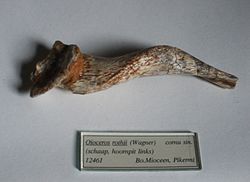- Oioceros
-
Oioceros
Temporal range: late Miocene
Oioceros rothii Scientific classification Kingdom: Animalia Phylum: Chordata Class: Mammalia Order: Artiodactyla Family: Bovidae Subfamily: Caprinae Genus: Oioceros
Gaillard, 1902Type species O. rothii Species O. rothii
O. atropatenes
O. jiulongkouensis
O. noverca
O. robustus
O. stenocephalus
O. lishanensis
O. wegneri
O. tanycerasOioceros is an extinct genus of sheep from the late Miocene. Its fossils have been found in Greece,[1] China,[2], Iran, and Africa. It was first discovered by Wagner in 1857, and contains nine species, O. rothii, O. atropatenes, O. jiulongkouensis, O. noverca, O. robustus, O. stenocephalus, O. lishanensis, O. wegneri, and O. tanyceras. Former species include O. grangeri (Pilgrim, 1934), now recognized as the genus Sinomegoceros, and O. xiejiaensis (Li and Qui; 1980), now recognized as the genus Sinopalaeoceros.[2]
Oioceros was somewhat resemblant of a gazelle, and represents the world's oldest-known bovid.[3]
Contents
Description
In 1997, an almost complete skull of O. rothii proved that it was similar to Samotragus praecursor, with a short face, compared to its relatively long braincase, and isolated horn cores.[1] However, unlike S. praecursor, O. rothii had a jaw of primarily premolar teeth, which were longer than the molars found in the latter.[1] Pilgrim and Hopwood described the genus as being "small size with long slender muzzle; face bent down on basicranial axis either slightly or to a moderate extent; orbits with expanded orbital roof; horn-cores twisted counter-clockwise in a fairly close spiral of one or two revolutions, widely separate, tilted backward or fairly upright, divergent, with a cross-section almost circular or elliptical, keeled either anteriorly or posteriorly or both; dentition moderately hypsodont, premolar series rather long and slender, molars broad with ribs of medium strength" (Pilgrim and Hopwood, 1928, p. 24). The horn cores of Oioceros have a torsion.[4]
Species
- Oioceros rothii was first named by Wagner in 1857.[1] He originally had the specimen he had found in Pikermi, Greece, under the name "Antilope rothii". In 1902, Gaillard reassigned the species to Oioceros rothii.[2]
- Oioceros atropatenes was first named by Rodler & Weithofer in 1890.[1]
- Oioceros jiulongkouensis was first named by G. Chen and W. Wu in 1976.
- Oioceros noverca was first named by Pilgrim in 1934.
- Oioceros robustus was first named by Chen and Wu in 1976.
- Oioceros stenocephalus was first named by Chen and Wu in 1976.
- Oioceros wegneri was first named by Andree in 1926. It possibly represents an entirely different genus of sheep.[1]
References
- ^ a b c d e f "Oioceros rothii (Wagner, 1857) from the late Miocene of Pikermi, Greece". University of Athens, Department of Historical Geology and Palaeontology, Panepistimiopolis. 1997. http://cat.inist.fr/?aModele=afficheN&cpsidt=15341180. Retrieved 2008-07-15.
- ^ a b c "The Phylogenetic Status of Oioceros from the Early to Middle Miocene of China". Guanfang Chen(Institute of Vertebrate Paleontology and Paleoanthropology, Academia Sinica). 1988-07. http://209.85.141.104/search?q=cache:cZYrYokRVYgJ:www.nau.edu/~qsp/will_downs/98.pdf+Oioceros&hl=en&ct=clnk&cd=6&gl=ca&lr=lang_en. Retrieved 2008-07-15.
- ^ "Miocene Sratigraphy and Fossil Mammals from the Xining Basin, Qinghai.". Chuankuei Li Qiu, Zhuding Qiu, and Shijie Wang. 1981-10. http://google.com/search?q=cache:KcUpHuaICWkJ:www.nau.edu/~qsp/will_downs/04.pdf+Oioceros&hl=en&ct=clnk&cd=20&gl=ca&lr=lang_en. Retrieved 2008-07-15.
- ^ "Description and Comparisons - Horn Core". paleo-electronica.org. 2005. http://palaeo-electronica.org/2005_1/mead11/descrip.htm. Retrieved 2008-07-15.
Further reading
- Mammoths, Sabertooths, and Hominids by Jordi Agusti and Mauricio Anton. Published 2002, Columbia University Press. ISBN 0231116403
- Classification of Mammals by Malcolm C. McKenna and Susan K. Bell. Published 1997, Columbia University Press. ISBN 0231110138
External links
- Oioceros at the Paleobiology Database
- Oioceras tanyceras at Zipcodezoo.com
- UAE Interact - A Walk Through Time
Categories:- Sheep
- Prehistoric bovids
- Miocene mammals
Wikimedia Foundation. 2010.
